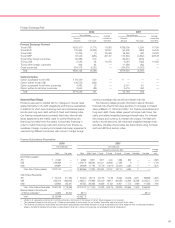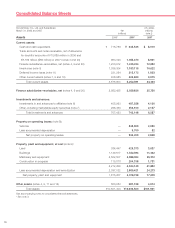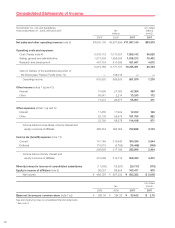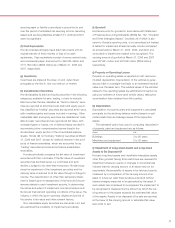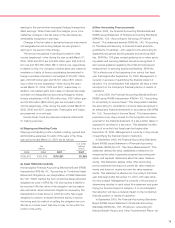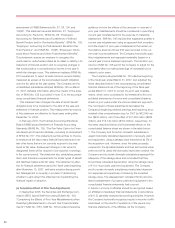Honda 2007 Annual Report Download - page 79
Download and view the complete annual report
Please find page 79 of the 2007 Honda annual report below. You can navigate through the pages in the report by either clicking on the pages listed below, or by using the keyword search tool below to find specific information within the annual report.
77
servicing asset or liability is amortized in proportion to and
over the period of estimated net servicing income. Servicing
assets and servicing liabilities at March 31, 2006 and 2007
were not significant.
(f) Cash Equivalents
Honda considers all highly liquid debt instruments with an
original maturity of three months or less to be cash
equivalents. Cash equivalents consist of money market funds
and commercial paper, and amount to ¥96,325 million and
¥117,182 million ($993 million) as of March 31, 2006 and
2007, respectively.
(g) Inventories
Inventories are stated at the lower of cost, determined
principally by the first-in, first-out method, or market.
(h) Investments in Securities
Honda classifies its debt and equity securities in the following
categories: available-for-sale, trading, or held-to-maturity.
Debt securities that are classified as “held-to-maturity” secu-
rities are reported at amortized cost. Debt and equity securi-
ties classified as “trading” securities are reported at fair value,
with unrealized gains and losses included in earnings. Other
marketable debt and equity securities are classified as “avail-
able-for-sale” securities and are reported at fair value, with
unrealized gains or losses, net of deferred taxes included in
accumulated other comprehensive income (loss) in the
stockholders’ equity section of the consolidated balance
sheets. Honda did not hold any “trading” securities at March
31, 2006 and 2007, except for retained interests in the sold
pools of finance receivables, which are accounted for as
“trading” securities and included in finance subsidiaries-
receivables.
Honda periodically compares the fair value of investment
securities with their cost basis. If the fair value of investment
securities has declined below our cost basis and such
decline is judged to be other-than-temporary, Honda recog-
nizes the impairment of the investment securities and the
carrying value is reduced to its fair value through a charge to
income. The determination of other-than-temporary impair-
ment is based upon an assessment of the facts and circum-
stances related to each investment security. In determining
the nature and extent of impairment, Honda considers such
factors as financial and operating conditions of the issuer, the
industry in which the issuer operates, degree and period of
the decline in fair value and other relevant factors.
Non-marketable equity securities are carried at cost, and
are examined the possibility of impairment periodically.
(i) Goodwill
Honda accounts for goodwill in accordance with Statement
of Financial Accounting Standards (SFAS) No. 142, “Goodwill
and Other Intangible Assets”. Goodwill, all of which is allo-
cated to Honda’s reporting units, is not amortized but instead
is tested for impairment at least annually. Honda completed
its annual tests for March 31, 2005, 2006, and 2007 and
concluded no impairment needed to be recognized. The
carrying amount of goodwill at March 31, 2006 and 2007
was ¥27,951 million and ¥30,590 million ($259 million),
respectively.
(j) Property on Operating Leases
Property on operating leases is reported at cost, less accu-
mulated depreciation. Depreciation of the vehicles is gener-
ally provided on a straight-line basis to an estimated residual
value over the lease term. The residual values of the vehicles
related to the operating leases are estimated at inception by
using our estimate of future used vehicle values, taking into
consideration data obtained from third parties.
(k) Depreciation
Depreciation of property, plant and equipment is calculated
principally by the declining-balance method based on esti-
mated useful lives and salvage values of the respective
assets.
The estimated useful lives used in computing depreciation
of property, plant and equipment are as follows:
Asset Life
Buildings 3 to 50 years
Machinery and equipment 2 to 20 years
(l) Impairment of Long-Lived Assets and Long-Lived
Assets to Be Disposed Of
Honda’s long-lived assets and identifiable intangibles assets
other than goodwill having finite useful lives are reviewed for
impairment whenever events or changes in circumstances
indicate that the carrying amount of an asset may not be
recoverable. Recoverability of assets to be held and used is
measured by a comparison of the carrying amount of an
asset to future net cash flows (undiscounted and without
interest charges) expected to be generated by the asset. If
such assets are considered to be impaired, the impairment to
be recognized is measured by the amount by which the car-
rying amount of the assets exceeds the estimated fair value
of the assets. Assets to be disposed of by sale are reported
at the lower of the carrying amount or estimated fair value
less costs to sell.


